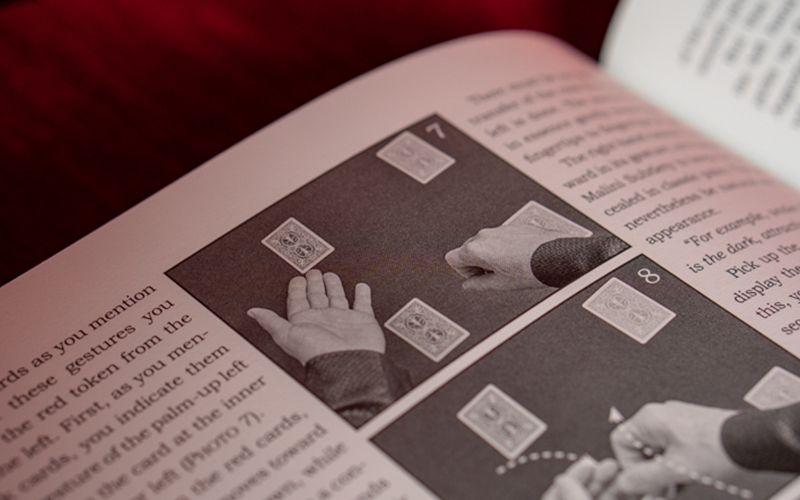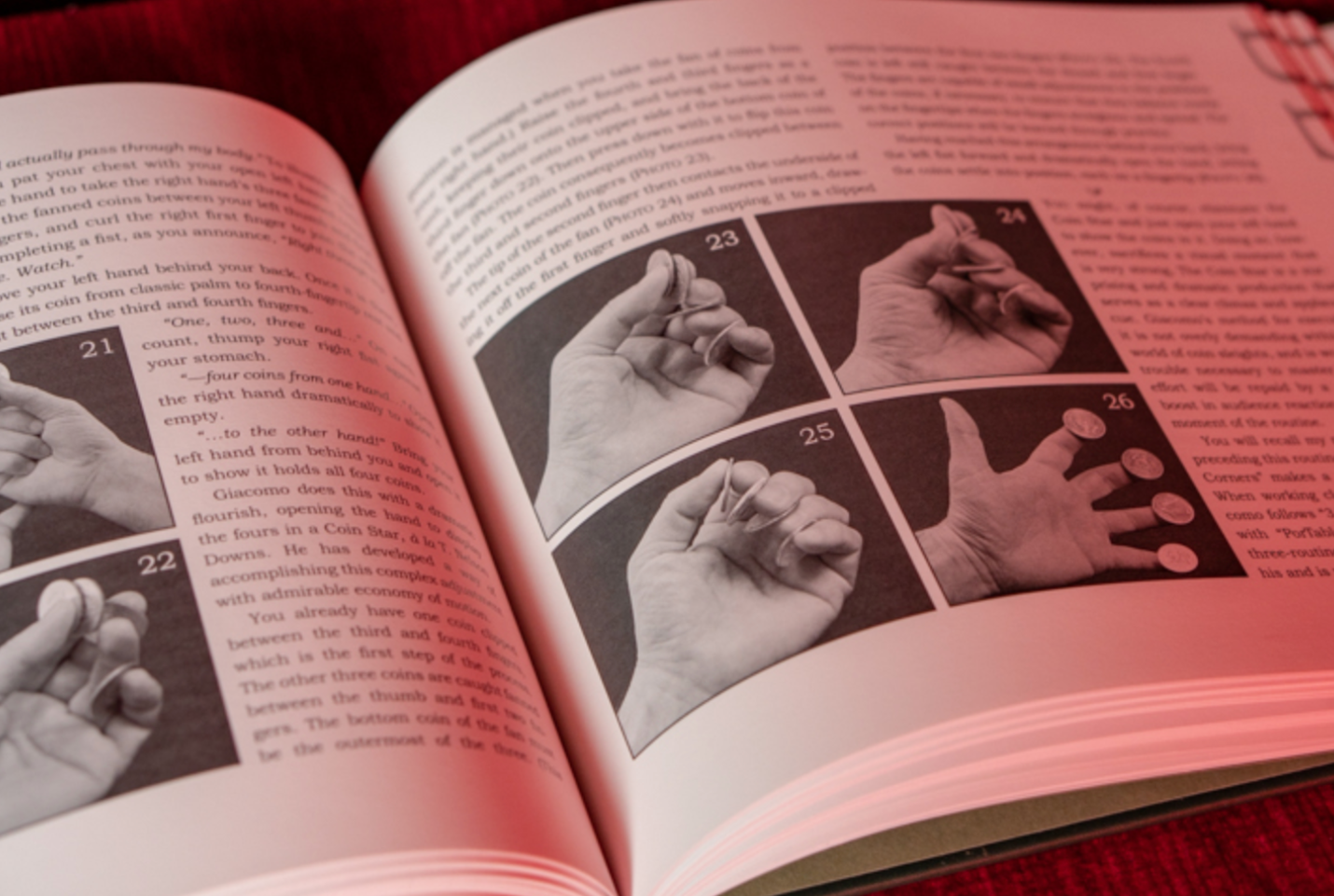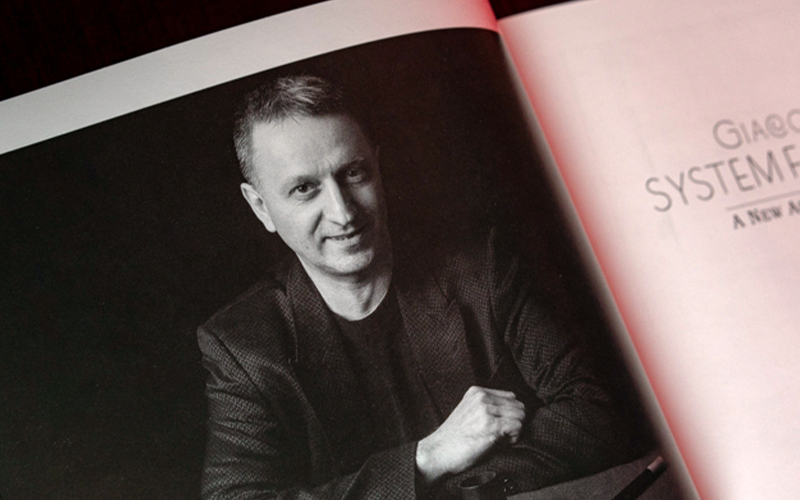Submitted by Jamy Ian Swiss on
Giacomo Bertini’s System for Amazement By Stephen Minch
Review by Jamy Ian Swiss
While sleight-of-hand card magic has experienced a steady increase in interest and innovation over the past century—from Dai Vernon’s revolutionary close analysis and refinement and the innovative explosions it seeded in the Sixties, Seventies and Eighties, through the contemporary impact and influence of the Spanish School led by Juan Tamariz in the Nineties and beyond—coin magic has plodded along in a far more steady state since the David Roth era, which began in the Seventies. There have been pockets of creativity in coin magic since that time, too. For example, consider the popularity of palm-out/fingers-up magic in the style of John Ramsay, the interest in Troy Hooser’s “exTROYdinary” (which was in turn influenced by Geoff Latta’s standup “Elfin Hoard”), and the decades of exploration of the Three-Fly plot. And for a while, it seemed that coin magic was hijacked by contrived concealments and “coin-fu” stylings.
But recently, three books of innovative coin magic, each reflecting its creator’s individual style and approach, present us with a wealth of new coin work to study. The first was in November 2017 when the Conjuring Arts released a lovely English edition of Luis Piedrahita’s 2011 volume, Coins and Other Fables (which I reviewed for the Lyons Den and also mentioned Miguel Ángel Gea’s important coin work). Then in the fall of 2018, Hermetic Press released The Long Goodbye: Geoff Latta on Coins by Stephen Minch and Stephen Hobbs. I have not reviewed this book due to my close association with the project as editor and hand model for the illustrations. Michael Close did however (read here), and declared the book “… destined to be one of the pillars in the literature of coin magic.”
The third is a manual that details the extraordinary coin work of Italian sleight-of-hand wonder, Giacomo Bertini—written by Stephen Minch and published by Hermetic Press (which is now owned by Penguin Magic). Giacomo Bertini's System for Amazement is almost as lovely as the spectacular magic it describes, detailing Bertini’s original approach to coin magic. It includes some fourteen original sleights and techniques, and thirteen ground-breaking routines.
—♦—

I first met Bertini in the early Nineties, when he looked up both Geoff Latta and me, and the three of us sessioned together. We’ve remained in touch over the ensuing twenty-five years, and in fact, last November I had the pleasure of performing and lecturing at his excellent European Close-up Magic Symposium. In the early 2000s, Chicago magician Steve Draun made a number of short videos of Bertini’s coin magic. Draun would then dub over with English translations, add titles and often include classical or jazz music, and thus, some amid the underground were fortunate to stay abreast of Bertini’s unique work. (A few of those videos can be found on YouTube; I provide several links below.)
Now, at last, the world of magic has access to Bertini’s distinctively stylish conjuring with coins. Stephen Minch does a fine job of analyzing and explaining the special features of Bertini’s work, beginning with a useful conceptual overview, which opens the first of the book’s two sections, entitled “Elements of the System.” Then more than a dozen sleights and techniques are described, some of which build expert enhancements on the work of predecessors like David Roth. Bertini takes well-known concealments like Fingertip Rest and the Classic Palm, techniques like the Retention Vanish, and tools like the Malini Subtlety, and bring them to a new level of refinement, relying solely on the fourth finger (frequently of either hand, as he is ambidextrous) instead of the second and third fingertips. Another example is his use of a somewhat altered approach to the Classic Palm that differs from the foundations so many of us learned from J.B. Bobo’s New Modern Coin Magic. With speed, breathtaking ease, and a deft lightness of touch, Bertini’s techniques are at times almost difficult to believe when read in text descriptions. However, the useful DVD that accompanies the book provides twenty minutes of excellent viewing of every sleight and technique described in this first section.
Make no mistake: these refinements and finesses are far from minor. They are significant and deliver tangible results in the form of vanishes, appearances, and changes. They are startling and mystifying, and will often fool magicians, albeit with methods grounded in principles we’ve been studying all of our lives. But Bertini’s work expands above and beyond his particular refinements. He also provides a set of techniques that include alternatives to standard handlings of shuttle passes, loads, and particularly acquitments that, rather than stinking of suspicion and unnaturalness, are stunning in their thorough effectiveness. Despite the fact that Bertini works standing, working without lapping, sleeving, or holdout vanishers, he makes coins so thoroughly appear and disappear that his hands seem constantly empty—even oftentimes to magicians desperately trying to keep up. And too, Bertini has a theory of “micro-misdirection” of keeping both hands moving at the same time within a relatively small focused visual frame, that keeps the effect clear, but at the same time effectively misdirects the actual sleight.
Admittedly, Bertini’s work is advanced, and mastery will not come quickly or easily. But especially to a new generation of magicians, Bertini opens the door to a style of coin magic that, while technically challenging, delivers practical results that is nowhere near as angle-specific as the specialized concealments that many have become so enamored of over the past twenty years, like the J.W. Grip/Palm. While at first blush Bertini’s work may read as angly, he has carefully addressed these concerns in the design of his work. On the video, you can see many of the methods filmed from different angles that serve to prove the potential and the practicality of these methods.

Bertini’s work will require significant practice. But to me, this is the kind of technique that is simultaneously challenging and fun, as you see results developing in the practice mirror. The deftness of touch, the speed with which he can capture a coin, or coins, in Classic Palm, the naturalness of the displays and transfers—none of this is easy, but all of it serves to produce results that are truly magical in appearance.
Those magical results can be readily appreciated when studying the second section of the book, “Routines From the System.” Students will certainly recognize the fundamental plots that are explored here—Copper/Silver transpositions, Spellbound, Coins Across, Coin Assemblies, the Portable Hole, and Ramsay’s Cylinder and Coins. But readers will not recognize Bertini’s unique approaches to construction and effect. These tricks look and feel different from many of the infinite small variations we are accustomed to seeing in much of the post-Rothian literature of coin magic. There is no filler here. No, instead we are given something quite different—differences that serve to render every one of the routines distinct.
“Swopper Silver” begins with the magical appearance of an African half-dollar-sized-coin with a hole in the center, followed by the production of a silver half dollar. These two coins then change places under extremely clean circumstances, and only two coins are used*.
“Coins and Corners” is the production of four coins that incorporates a clever presentation while relying on an excellent and innovative use of Edge Grip Concealment. The coins seem to come from nowhere and magically “pop” into view each time. This is one of several remarkable and original production techniques included in the book, including his Edge Grip Production described in the first section. This technique and effect might well be worth the price of the book to anyone who masters it. It delivers a dazzling visual effect that begins with two empty hands, whereupon four coins are produced, one at a time, with each coin’s appearance suddenly adding to a growing fan of coins held at the fingertips of one hand—without any interim transfers or counts. This is a stunning and purely visual effect that, in the overused and abused clichés of catalog-speak, will leave your audiences gasping.
With “3Across and 1Through,” Bertini tackles the Coins Across plot in a distinctive fashion with the final coin passing through the performer’s body, and the finale including the presentation of the four coins balanced on the tips of the fingers in the classic Coin Star display, but in a clever and practical close-up application.

In the “Florentine Assembly,” using four coins and two playing cards as covers, the performer’s hands are repeatedly seen to be empty between transpositions. At the conclusion of the routine, all four coins magically transform into a jumbo coin. Note this is not the typical overkill of the mere added production of a large coin, but rather an amazing final transformation.
I particularly enjoyed reading and envisioning Bertini’s two routines for John Ramsay’s “Cylinder and Coins.” The first version is a formal routine, which looks extremely clean at every moment, and also provides a remarkable feature that should thoroughly amaze lay audience and magicians alike, when the coins that have appeared within the cylinder are tossed out singly onto the table. Once again, Bertini’s approach is something new and worthy of consideration—neither minor variations of equally minor noteworthiness, nor novelty for impractical novelty’s sake. Serious students should take note.
His second version for the Cylinder and Coins is done with poker chips (as Dai Vernon originally innovated), along with some subtle gimmickry that serve to provide an extremely practical handling that Bertini routinely uses—and which, as author Stephen Minch observes, “is also possibly the least demanding handling of ‘Cylinder and Coins’ … ever published.”
Bertini provides two approaches to Roth’s neoclassic Portable Hole, each distinct and far more than mere variation. The first of these, “Black Hole,” utilizes a stiffened felt “hole” and also contributes a nice presentational angle. The second, “PorTable Hole,” serves as a hook for what is really a different approach to the Coins Through the Table plot, and concludes with the magical appearance of four small “black holes.”
Following the penultimate entry—“Coinmeleon,” a compact and magical version of Spellbound—the book concludes with an entirely original plot, “Fort Knox,” in which coins appear to be gradually “3-D printed” in a magical fashion. This one is difficult to describe succinctly, but the props are distinct and memorable, and in true Rothian manner, Bertini bequeaths a new and novel coin plot. It’s actually one of two such originalities, the other being “Poles Apart,” a cleverly constructed multi-phase routine in which half dollars apparently become magnetic—a description that does no justice to a very deceptive and novel creation.
The Hermetic Press production details are elegant, with the “landscape” design echoing that of the Geoff Latta book, a useful styling as it is conducive to the book remaining open and flat on the table without weighted assistance. After so many years and volumes of reading Stephen Minch’s stylish prose, I suspect magicians have come to take his stellar literary skills for granted. But I cannot fail to take note when reading this turn of phrase as he describes Bertini’s preference for instantly transferring a coin to Classic Palm immediately following a Retention Vanish (a generally frowned upon procedure): “This might be viewed as running without need of pursuit, but it is really a precaution to ensure that the chase is never contemplated.” As always, Minch’s style is a pleasure to read and to digest, and I also find myself occasionally delighted by the admittedly contrived titles, for example in the case of “Financial Backing,” a title for an effect in which images of coins appear printed on the backs of several playing cards.
I thoroughly enjoyed studying Giacomo Bertini’s System for Amazement, a book of coin magic that reflects genuine innovation, useful sleights, and beautiful magic routines—a substantial and unarguably important addition to the literature of coin magic.
* ENDNOTE In the course of this routine, Bertini provides two small details on the Earl “Presto” Johnson Palm Change that, while they do not appear in the original description in Kaufman’s Coinmagic (which also lacked the correct credit, later updated in Roth’s Expert Coin Magic), are useful but also predate Bertini, perhaps not to his knowledge. While Kaufman original described the palmed coin falling to the third and fourth fingers, I learned the sleight from the originator himself in my teens, and I do not execute the move that way; rather the coin falls toward the second and third fingers, with the same intention as Bertini’s detail, which is advantageous positioning for the next step in the sleight. Also, a technique that Bertini describes for helping to prevent the dreaded tell of the popping of the thumb—namely, gently touching the tips of the thumb and first fingers to each other during the action of the move—has been previously described in years past by David Roth in instructional video.
—♦—
Giacomo Bertini’s System for Amazement—By Stephen Minch. Hardbound with dust jacket, 10 x 8 inches, 161 pages, illustrated with hundreds of black and white photographs. Published by Hermetic Press and Penguin Magic (2018), includes DVD. Price: $79.95
Seeing Is Believing
Here are five short videos that offer a nice sampling of Giacomo Bertini’s distinctive style of and approach to coin magic.
Vanish & Reproduction by Giacomo Bertini
In the book, this is titled as “Here, Gone and Back Again,” a perfect succinct example of Bertini’s work.
Florentine Assembly
Coinmeleon (Spellbound)
The translated narration is the voice of Steve Draun.
Ambitious Coin
While this exact routine is not described in System of Amazement, it utilizes several of Bertini’s original techniques.
Portable Hole
Again, the translated narration is the voice of Steve Draun.
SEE LYONS DEN INDEX









